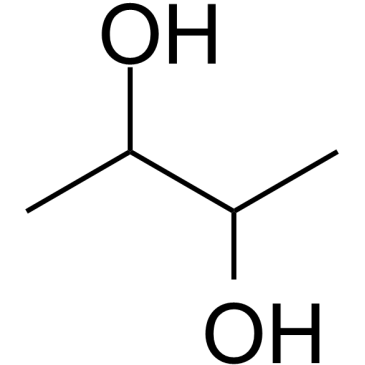2,3-丁二醇

2,3-丁二醇结构式

|
常用名 | 2,3-丁二醇 | 英文名 | (2R,3R)-(-)-2,3-Butanediol |
|---|---|---|---|---|
| CAS号 | 513-85-9 | 分子量 | 90.121 | |
| 密度 | 1.0±0.1 g/cm3 | 沸点 | 180.7±0.0 °C at 760 mmHg | |
| 分子式 | C4H10O2 | 熔点 | 25 °C(lit.) | |
| MSDS | 美版 | 闪点 | 85.0±0.0 °C |
|
Analysis of eight glycols in serum using LC-ESI-MS-MS.
J. Anal. Toxicol. 38(9) , 676-80, (2014) A liquid chromatography coupled with electrospray tandem mass spectrometry method was developed for the analysis of ethylene glycol, diethylene glycol, triethylene glycol, 1,4-butanediol, 1,2-butanediol, 2,3-butanediol, 1,2-propanediol and 1,3-propanediol, in... |
|
|
Transcriptional responses to sucrose mimic the plant-associated life style of the plant growth promoting endophyte Enterobacter sp. 638.
PLoS ONE 10(1) , e0115455, (2015) Growth in sucrose medium was previously found to trigger the expression of functions involved in the plant associated life style of the endophytic bacterium Enterobacter sp. 638. Therefore, comparative transcriptome analysis between cultures grown in sucrose ... |
|
|
Comprehensive utilization of glycerol from sugarcane bagasse pretreatment to fermentation.
Bioresour. Technol. 196 , 194-9, (2015) In this study, the effects of glycerol pretreatment on subsequent glycerol fermentation and biomass fast pyrolysis were investigated. The liquid fraction from the pretreatment process was evaluated to be feasible for fermentation by Paenibacillus polymyxa and... |
|
|
Genome Engineering of the 2,3-Butanediol Biosynthetic Pathway for Tight Regulation in Cyanobacteria.
ACS Synth. Biol. 4 , 1197-204, (2015) Cyanobacteria have gained popularity among the metabolic engineering community as a tractable photosynthetic host for renewable chemical production. However, though a number of successfully engineered production systems have been reported, long-term genetic s... |
|
|
The genome of Pelobacter carbinolicus reveals surprising metabolic capabilities and physiological features.
BMC Genomics 13 , 690, (2012) The bacterium Pelobacter carbinolicus is able to grow by fermentation, syntrophic hydrogen/formate transfer, or electron transfer to sulfur from short-chain alcohols, hydrogen or formate; it does not oxidize acetate and is not known to ferment any sugars or g... |
|
|
Plasma amino acid levels with a note on membrane transport: characteristics, regulation, and metabolic significance.
Nutrition 18(9) , 761-6, (2002) The plasma concentration of an amino acid (AA) is the result of its rates of appearance (Ra) in and disappearance (Rd) from plasma. As for most nutrients, AA Ra and Rd are tightly regulated and at the postabsorptive state Ra equals Rd. Factors controlling Ra ... |
|
|
A new method for determination of serum cholestanol by high-performance liquid chromatography with ultraviolet detection.
J. Chromatogr. B. Biomed. Sci. Appl. 742(2) , 345-52, (2000) We developed a method for the determination of serum 5alpha-cholestan-3beta-ol (cholestanol). The sterols were derivatized to the 4'-bromobenzenesulfonyl esters and heated in isopropanol. The cholesterol-4'-bromobenzenesulfonate was solvolyzed to cholesteryl ... |
|
|
A monoclonal antibody-based enzyme-linked immunosorbent assay of glycolithocholic acid sulfate in human urine for liver function test.
Steroids 67(10) , 827-33, (2002) Urinary levels of sulfated metabolites of lithocholic acid (LCA) are expected to be a useful index of liver function. Thus, a sensitive, specific, and feasible enzyme-linked immunosorbent assay (ELISA) of these sulfated LCA metabolites (LCA-Suls) should be es... |
|
|
Higher levels of plasma cholesterol sulfate in patients with liver cirrhosis and hypercholesterolemia.
Lipids 28(9) , 833-6, (1993) An analytical method for the determination of cholesterol sulfate (CS) in plasma using gas-liquid chromatography was developed. We measured plasma CS concentrations in patients with liver cirrhosis and hypercholesterolemia as examples of disorders that involv... |
|
|
Characterization of serum and urinary bile acids in patients with primary biliary cirrhosis by gas-liquid chromatography-mass spectrometry: effect of ursodeoxycholic acid treatment.
J. Lipid Res. 30(12) , 1953-62, (1989) We have studied the effect of ursodeoxycholic acid on the serum and urinary bile acids in seven patients with moderate to severe primary biliary cirrhosis. Bile acids were characterized by gas-liquid chromatography-mass spectrometry and quantified by capillar... |